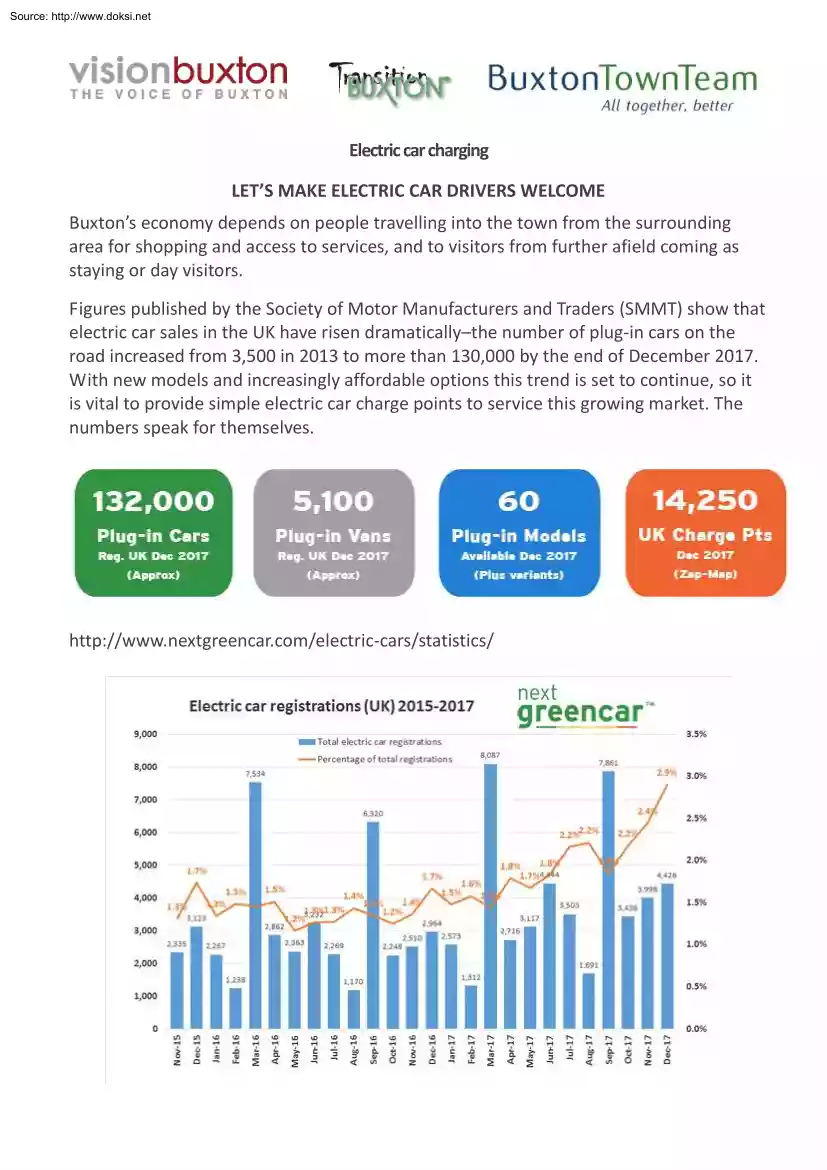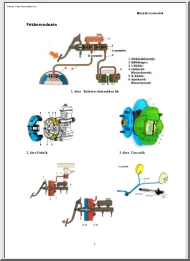Datasheet
Year, pagecount:2018, 4 page(s)
Language:English
Downloads:5
Uploaded:October 24, 2019
Size:1 MB
Institution:
-
Comments:
Attachment:-
Download in PDF:Please log in!
Comments
No comments yet. You can be the first!Most popular documents in this category
Content extract
Source: http://www.doksinet Electric car charging LET’S MAKE ELECTRIC CAR DRIVERS WELCOME Buxton’s economy depends on people travelling into the town from the surrounding area for shopping and access to services, and to visitors from further afield coming as staying or day visitors. Figures published by the Society of Motor Manufacturers and Traders (SMMT) show that electric car sales in the UK have risen dramatically–the number of plug-in cars on the road increased from 3,500 in 2013 to more than 130,000 by the end of December 2017. With new models and increasingly affordable options this trend is set to continue, so it is vital to provide simple electric car charge points to service this growing market. The numbers speak for themselves. http://www.nextgreencarcom/electric-cars/statistics/ Source: http://www.doksinet According to cleantechnica.com, the average electric car buyer is in their mid-40s and earning in excess of £100,000 per annum, but both of these figures are
gradually coming down as the vehicles become more affordable and the infrastructure to support them becomes more available. Electric car charge points are unobtrusive. They increase the likelihood of discerning consumers visiting the location and businesses in the vicinity of the chargers. Grants are available to subsidise the already fairly low cost of installation. As detailed in the map below, Buxton and the Peak District are behind the curve in providing the facilities to allow electric car drivers to visit and feel welcome. If we want this growing group to visit us or to break their journey (and spend their money) we need to provide the facilities they require. Transition Buxton has put together this short paper to try to encourage operators and owners of premises with car parking facilities to respond to this opportunity. With thanks to https://www.zap-mapcom/ for the above map For more detailed information about the different types of charge points and an Installation Guide
please visit our website here: www.transitionbuxtoncouk/what-wedo/transport/electriccarcharging and follow the links below for information about grants Source: http://www.doksinet to reduce the cost of installation. Electric Car Charge Point Types There are three types / speeds of EV charge points: Rapid charging units (43, 50, or 120kW) can provide an 80% charge in around 30 minutes; Fast charging points (7-22kW) can fully recharge some models in 3-4 hours; Slow charging points (up to 3kW) are used for longer charging times, around 6-8 hours. Rapid chargers are the fastest way to charge an EV. Units supply high power direct or alternating current – AC or DC – to recharge a car to 80% in 20-40 minutes. All come with the charging cable tethered to the unit, with one of three connectors attached. Rapid charging can only be used on vehicles with rapid-charging capability. Users of rapid DC units select the appropriate connector for their vehicle and use the tethered cable to plug
the car in, rather than their own cable. Tesla’s Supercharger network also provides Rapid DC charging to drivers of its cars, but at a much higher rate of up to 120kW. Like other Rapid DC units, the cable is tethered to the unit, but the connector at the end is Tesla’s version of Type 2. While all Tesla models are designed for use with Supercharger units, many Tesla owners use adaptors which enable them to use a 50kW rapid units fitted with a CHAdeMO connector. While these provide less power than a Supercharger, they are far more common in the UK and elsewhere. EV models that use CHAdeMO rapid charging include the Nissan Leaf, Mitsubishi Outlander PHEV, and Kia Soul EV. CCS compatible models include the BMW i3, VW eGolf, and Hyundai Ioniq Electric Tesla’s Model S and Model X are exclusively able to use the Supercharger network, while the only model currently able to charge on Rapid AC is the Renault Zoe. Fast chargers, all of which are AC are either untethered or have tethered
cables and typically rated at either 7kW or 22 kW (single- or three-phase 32A). Charging times vary on unit speed and the vehicle, but a 7kW charger will recharge a compatible EV in 3-5 hours, and a 22kW charger in 1-2 hours. These type of chargers tend to be found at Source: http://www.doksinet destinations, such as car parks, supermarkets, or shopping centres – somewhere that an EV will potentially be parked at for an hour or more. Almost all EVs and PHEVs are able to charge at Type 2 units, with the correct cable. It is by far and away the most common public charge point, and most plug-in car owners will have a cable with a Type 2 connector charger-side. Slow charging units are rated at 3kW. Charging times vary on unit speed and vehicle, but a full charge for an EV will typically take 6-12 hours. Slow charging is the most common method of charging electric vehicles to charge at home overnight. Slow units aren’t necessarily restricted to home use, with workplace and public
points also to be found. Slow charging units can be either tethered or untethered Although termed 3kW units, slow home charge points can actually potentially charge at up to 3.6kW, because they can be rated for 16A, rather than the 13A or less available from the mains. All plug-in electric vehicles can charge using at least one of the above slow connectors. Often home charge points will be compatible with the same Type 2 cable used for public charging, or be tethered with the a Type 1 connector where this is suitable for a particular EV. Useful links: http://ukevse.orguk/charge-points-chargers/charge-point-grantsschemes/ https://www.govuk/government/collections/government-grants-for-low-emissionvehicles And in case you need a little inspiration: Fully Charged show with Robert Llewellyn about recent developments in renewables and EVs. https://youtube/yaC1qgXaRvE
gradually coming down as the vehicles become more affordable and the infrastructure to support them becomes more available. Electric car charge points are unobtrusive. They increase the likelihood of discerning consumers visiting the location and businesses in the vicinity of the chargers. Grants are available to subsidise the already fairly low cost of installation. As detailed in the map below, Buxton and the Peak District are behind the curve in providing the facilities to allow electric car drivers to visit and feel welcome. If we want this growing group to visit us or to break their journey (and spend their money) we need to provide the facilities they require. Transition Buxton has put together this short paper to try to encourage operators and owners of premises with car parking facilities to respond to this opportunity. With thanks to https://www.zap-mapcom/ for the above map For more detailed information about the different types of charge points and an Installation Guide
please visit our website here: www.transitionbuxtoncouk/what-wedo/transport/electriccarcharging and follow the links below for information about grants Source: http://www.doksinet to reduce the cost of installation. Electric Car Charge Point Types There are three types / speeds of EV charge points: Rapid charging units (43, 50, or 120kW) can provide an 80% charge in around 30 minutes; Fast charging points (7-22kW) can fully recharge some models in 3-4 hours; Slow charging points (up to 3kW) are used for longer charging times, around 6-8 hours. Rapid chargers are the fastest way to charge an EV. Units supply high power direct or alternating current – AC or DC – to recharge a car to 80% in 20-40 minutes. All come with the charging cable tethered to the unit, with one of three connectors attached. Rapid charging can only be used on vehicles with rapid-charging capability. Users of rapid DC units select the appropriate connector for their vehicle and use the tethered cable to plug
the car in, rather than their own cable. Tesla’s Supercharger network also provides Rapid DC charging to drivers of its cars, but at a much higher rate of up to 120kW. Like other Rapid DC units, the cable is tethered to the unit, but the connector at the end is Tesla’s version of Type 2. While all Tesla models are designed for use with Supercharger units, many Tesla owners use adaptors which enable them to use a 50kW rapid units fitted with a CHAdeMO connector. While these provide less power than a Supercharger, they are far more common in the UK and elsewhere. EV models that use CHAdeMO rapid charging include the Nissan Leaf, Mitsubishi Outlander PHEV, and Kia Soul EV. CCS compatible models include the BMW i3, VW eGolf, and Hyundai Ioniq Electric Tesla’s Model S and Model X are exclusively able to use the Supercharger network, while the only model currently able to charge on Rapid AC is the Renault Zoe. Fast chargers, all of which are AC are either untethered or have tethered
cables and typically rated at either 7kW or 22 kW (single- or three-phase 32A). Charging times vary on unit speed and the vehicle, but a 7kW charger will recharge a compatible EV in 3-5 hours, and a 22kW charger in 1-2 hours. These type of chargers tend to be found at Source: http://www.doksinet destinations, such as car parks, supermarkets, or shopping centres – somewhere that an EV will potentially be parked at for an hour or more. Almost all EVs and PHEVs are able to charge at Type 2 units, with the correct cable. It is by far and away the most common public charge point, and most plug-in car owners will have a cable with a Type 2 connector charger-side. Slow charging units are rated at 3kW. Charging times vary on unit speed and vehicle, but a full charge for an EV will typically take 6-12 hours. Slow charging is the most common method of charging electric vehicles to charge at home overnight. Slow units aren’t necessarily restricted to home use, with workplace and public
points also to be found. Slow charging units can be either tethered or untethered Although termed 3kW units, slow home charge points can actually potentially charge at up to 3.6kW, because they can be rated for 16A, rather than the 13A or less available from the mains. All plug-in electric vehicles can charge using at least one of the above slow connectors. Often home charge points will be compatible with the same Type 2 cable used for public charging, or be tethered with the a Type 1 connector where this is suitable for a particular EV. Useful links: http://ukevse.orguk/charge-points-chargers/charge-point-grantsschemes/ https://www.govuk/government/collections/government-grants-for-low-emissionvehicles And in case you need a little inspiration: Fully Charged show with Robert Llewellyn about recent developments in renewables and EVs. https://youtube/yaC1qgXaRvE





